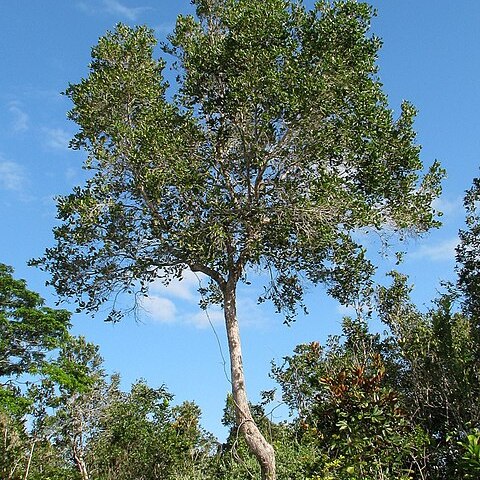Trees or shrubs, dioecious. Indumentum consisting of simple, hirsute to sericeous hairs, glabrescent. Stipules very asymmetric, early caducous. Leaves simple, distichous; petiole not to slightly pulvinate; blade (a)symmetric, coriaceous, punctate, base broadly attenuate, margin entire (to laxly sinuate), apex acuminate (to cuspidate), both surfaces (sub)glabrous; venation pinnate, looped and closed at the margin, indistinctly reticulate. Inflorescences dense axillary clusters of flowers (reduced thyrses), brachyblasts increasing in size with age. Bracts on brachyblasts, 4 surrounding each flower. Flowers actinomorphic; sepals 4(-5), 2 outside (outside sericeous), and 2(-3; see note) inside (outside with central sericeous band), spreading horizontally or reflexed, inside glabrous, third inner sepal petal-like, often with claw; petals absent (see note). Staminate flowers: pedicels with abscission zone; disc annular, lobed, toothed; stamens 8-15, absent in pistillate flowers (see note 2 under the species), in Malesia with an androphore from which the filaments branch alternately, androphore apically with a pilose, 3-lobed pistillode; anthers basifixed, opening latrorse with a slit, bend upwards. Pistillate flowers: pedicels elongating in fruit; disc with more numerous and narrower teeth than staminate flowers; pistil: ovary (on short gynophore), 3(-4)-locular, densely hirsute; ovules one per locule, descending, epitropous, anatropous, attached halfway to column; styles 3, short, hirsute; stigmas divided up to the style, above with dendritic papillae, on lower surface hirsute. Fruit a rhegma, subglobose, in Malesia outside densely echinate with glochidiate hairs, inside glabrous, dehiscing septicidally into 3(-4) segments, latter almost loculicidally split to the base; wall thin, woody. Seeds ovoid, flattened, 1-3 per fruit, black, glossy, covered in upper third by a thin aril; endosperm absent.
More
Male flowers small; pedicels short, jointed; sepals 4–6, free, imbricate; petals absent; disk glands extrastaminal, free; stamens 5–16, borne on a column, anthers extrorse, dorsifixed, connective broad, the cells longitudinally dehiscent; pistillode trifid, hairy.
Female flowers small; pedicels short; sepals ± as in the male flowers; petals absent; disk hypogynous, cupular, crenellate; ovary 3-celled, with 1 ovule per cell; styles 3, ± free, bifid or bipartite, stigmas fimbriate or papillose.
Fruit ellipsoid-subglobose, dehiscing into bivalved cocci; exocarp tuberculate, setiferous, or both; endocarp woody; columella persistent.
Flowers in axillary fascicles, the male fascicles many-flowered, the female fascicles few-flowered; bracts minute.
Seeds compressed-ovoid; testa crustaceous; caruncle bipartite, fleshy; albumen fleshy; cotyledons broad, flat.
Leaves alternate, shortly petiolate, stipulate, simple, entire, penninerved, eglandular.
Dioecious trees or shrubs, with a hirsute and sericeous indumentum.

